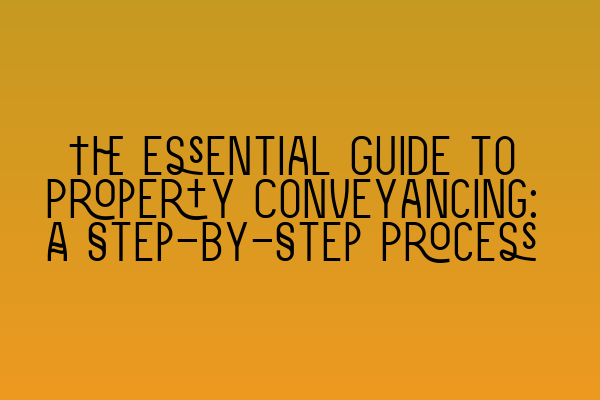The Essential Guide to Property Conveyancing: A Step-by-Step Process
Are you planning to buy or sell a property? Property conveyancing is a crucial step in the process, ensuring a smooth and legally sound transition of ownership. Whether you are a first-time buyer or a seasoned property investor, it is essential to understand the conveyancing process to avoid any complications down the line.
At SQE Property Law & Land Law, we have helped numerous clients navigate the intricacies of property conveyancing. In this comprehensive guide, we will take you through the step-by-step process of property conveyancing, clarifying key concepts and providing invaluable tips along the way.
Step 1: Finding a Solicitor
The first step in the property conveyancing process is to find a reputable solicitor to represent you. Your solicitor will handle all the legal aspects of the transaction, ensuring that your rights are protected and guiding you through the entire process. At SQE Property Law & Land Law, our experienced solicitors are well-versed in property law and are dedicated to providing excellent service to our clients.
Step 2: Preliminary Checks and Instructions
Once you have engaged a solicitor, they will conduct preliminary checks and gather necessary information to initiate the conveyancing process. This includes obtaining the title deeds and any relevant documentation from the seller, instructing a surveyor to conduct a property survey, and performing necessary searches such as local authority, environmental, and drainage searches.
Step 3: Drafting and Reviewing Contracts
Next, your solicitor will draft the contract of sale, taking into account the terms and conditions agreed upon by both parties. It is essential to review this contract carefully to ensure that all the necessary details are included and that your interests are protected. Your solicitor will also liaise with the seller’s solicitor to negotiate any amendments or additional conditions that may be required.
Step 4: Mortgage Arrangements
If you are obtaining a mortgage to finance the purchase, this is the time to make the necessary arrangements. Your solicitor will work closely with your mortgage lender to ensure that all legal requirements are met and that funds are available for completion. It is advisable to seek independent financial advice to determine the most suitable mortgage product for your particular circumstances.
Step 5: Exchange of Contracts
Once all the necessary checks, searches, and negotiations have been completed satisfactorily, it is time for the exchange of contracts. This is a crucial step in the process, as it legally binds both parties to the transaction. At this stage, you will be required to pay a deposit, usually 10% of the purchase price, which will be held in a designated client account by your solicitor.
Step 6: Pre-Completion Checks and Arrangements
Prior to completion, your solicitor will undertake additional checks to ensure that there are no outstanding issues that may affect the property’s value or your ability to take ownership. This may involve verifying planning permissions, rights of way, and any outstanding charges or arrears. It is also recommended to arrange buildings insurance for the property, effective from the date of completion.
Step 7: Completion
On the agreed completion date, your solicitor will transfer the balance of the purchase price to the seller’s solicitor. Once the funds have been received and all legal formalities have been completed, you will officially become the legal owner of the property. Your solicitor will register the transfer of ownership with the Land Registry and provide you with the necessary documentation, including the title deeds.
Step 8: Post-Completion Matters
After completion, there are still a few matters that need to be addressed. These include paying any outstanding Stamp Duty Land Tax, updating utility providers and the local council of the change in ownership, and ensuring that your interests are protected through appropriate insurance coverage. Your solicitor will assist you in completing these post-completion tasks and provide guidance on any further legal obligations.
Conclusion
Property conveyancing is a complex process, and having the right solicitor by your side can make all the difference. At SQE Property Law & Land Law, we are dedicated to providing expert advice and exceptional service to our clients. By following the steps outlined in this guide and seeking professional guidance throughout the process, you can ensure a successful and stress-free property transaction.
For more information about preparing for the SQE exams or to explore our SQE preparation courses, visit our related articles:
– SQE 1 Practice Exam Questions
– SQE 1 Practice Mocks FLK1 FLK2
– SQE 2 Preparation Courses
– SQE 1 Preparation Courses
– SRA SQE Exam Dates
Feel free to reach out to our expert solicitors at SQE Property Law & Land Law for personalized advice and assistance with all your property conveyancing needs. We are here to help you through every step of the process.
